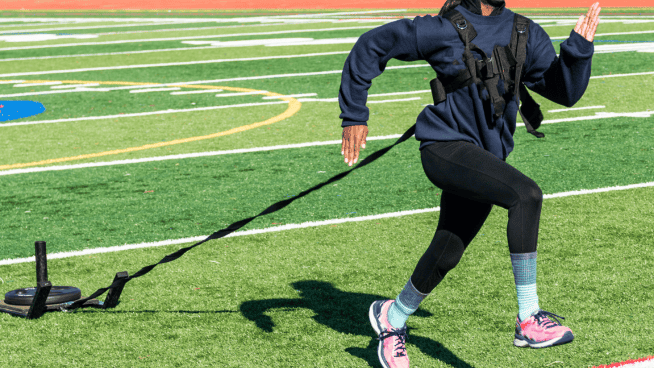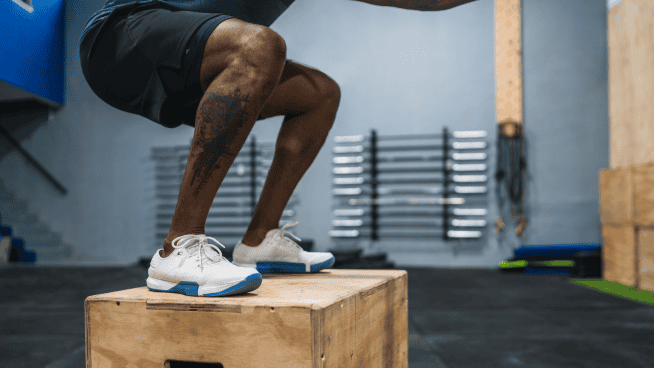6 Tests to Identify a Strength Weakness
![]()
You can tell whether you are strong or not fairly easily. Can’t do more than five Pull-Ups? You need to work on your back strength. Can’t hold a Plank more than 20 seconds? You have core strength issues.
It’s not rocket science.
However, things get complicated if you are already reasonably strong in the weight room. You may be able to crush an exercise, but there might be a lingering weakness in an area of your body that you inadvertently ignore. Odds are you have some type of weakness.
For example, let’s say your back strength isn’t up to par. Yes, you can knock out 10-plus Pull-Ups and can Row a ton of weight with no problem. But once you try to deadlift a heavy weight, your back rounds and your muscles scream afterward. The muscles along your spine simply aren’t up to par. No doubt, some of your back muscles are strong, but you need every muscle to be strong.
Ignoring such a weakness can screw up your exercise form, impair your performance in your sport or, worse, cause an injury.
Not good.
So it’s time to swallow your ego and find the areas of your body that still need work. The six tests below from Dr. Joel Seedman, an exercise physiologist and owner of AdvancedHumanPerformance.com, will help identify problematic strength weaknesses. These tests are for athletes (and others) who have experience with weight training; they are not for beginners.
RELATED: The Importance of Foot and Ankle Workouts
Barbell RDL Test
Passing Score: You should be able to RDL a weight that’s 75-80 percent of your one-rep Deadlift or Squat max with a flat back.
A heavy Barbell RDL exposes strength and spinal stability issues. At the bottom position when the bar weights are a few inches off the ground, there’s a ton of loading on the spinal erectors and stabilizers, and through the entire back, glutes and hamstrings. If there’s a weakness, your back will round.
“If an athlete can’t keep a flat back or neutral spine using heavy weights, they are going to have trouble performing any type of heavy movement correctly,” says Seedman. “This test gives me an indication of whether or not they have good posture and can achieve that neutral spinal alignment on heavy movements, like Squats, Deadlifts and Rows.”
The Fix: Perform Barbell RDLs and pause at the bottom position for 3 seconds on each rep. This strengthens weak muscles that might be causing you to fail the test, and will ultimately make you stronger on other lifts. Also, try Single-Leg RDLs to improve symmetry between your glutes. Ideally, you should be able to lift a weight equivalent to your body weight.
[youtube video=”NVStWkTAFEU” /]Dumbbell Bench Test
Passing Score: Perform the Dumbbell Bench Press with a combined weight equal to 80 percent of your Bench Press for the same number of reps.
Cheating on the Bench Press is easy to do. Seedman says that many people are stronger on one side than the other, have poor stability or tend to bounce the bar off their chest. They can lift a lot of weight, but they have fundamental issues.
The Dumbbell Bench Press Test exposes those issues. “Dumbbells minimize the amount of cheating,” he says. “If you can’t handle 80 percent of your Bench max, your technique on Bench Press is probably pretty lousy.”
The Fix: For one, do more work with the Dumbbell Bench Press. Also, incorporate pause work into pressing movements to eliminate the momentum and even out imbalances. For example, try lowering the bar or dumbbells over 3 seconds and pause at the bottom for another 3 seconds on each rep.
[youtube video=”v7Jbefudvts” /]RELATED: Use This Lifting Technique to Add Weight to Your Bench Press
Farmer’s Walk Test
Passing Score: Walk for 40 yards carrying dumbbells that, when combined, equal your bodyweight.
The Farmer’s Walk Test is as simple as they come. Grab some dumbbells and walk. It’s also a fantastic test of overall strength. Many of you may be able to do this for a short distance, but handling heavy weights for 40 yards while maintaining control and posture can be quite difficult.
“It’s going to give a great indication of grip strength, back strength, core strength, posture and generally full-body strength,” Seedman explains. “Handling your body weight is a must for an average athlete, and even more important for an elite-level athlete.”
The Fix: This fix is fairly straightforward: Perform more Farmer’s Walks and gradually increase the weight you carry, just like you would any other exercise. Also, try Single-Arm Farmer’s Walks, which improve core strength and control when you walk with heavy weight.
[youtube video=”3ucSg4kVyiM” /]Single-Leg Balance Test
Passing Score: Do a Single-Leg Stand with your eyes closed and your feet facing forward. If you can’t hold this position for at least 1 minute—and especially if you fall forward and toward the middle—you fail. Test each side a few times and compare your average times to see if one side works better than the other.
The Single-Leg Balance Test might seem like the easiest of them all. You just stand there for a minute. How hard can that be?
According to Seedman, this test exposes glute inactivity, which is a major problem. If your glutes aren’t firing properly, you will lack power and strength in the weight room and in your sports skills. Also, glute inactivity can result in a plethora of issues, including lower-back and knee pain.
The Fix: Learn how to get your glutes firing properly with advice from Seedman in this article.
Eyes Closed Test
Passing Score: Lift 80-90 percent of the weight you typically handle on any exercise with your eyes closed.
Closing your eyes on an exercise changes everything. Because you can no longer see your limbs, your brain relies solely on sensors in your muscles to know where your limbs are located. This is called proprioception.
Once you close your eyes, you won’t be able to lift quite as much weight because of a small stability loss. Ideally, the loss should only be 10-20 percent.
“If you can’t handle the load and it’s all over the place, then this indicates you aren’t controlling the load,” says Seedman. “This gives me information on whether or not your muscles are providing sensory information and your muscles are firing.”
In general, people have a tendency to hastily add weight when they shouldn’t, and this test detects just that.
The Fix: If you can’t pass this test, you are using too much weight on the exercise. Lower the weight for now and perfect your technique, then gradually make progress.
[youtube video=”bQYn9s1IF3g” /]Renegade Row Test
Passing Score: Perform the exercise with dumbbells equivalent to half of your body weight, while maintaining a flat back and keeping your hips square to the ground. For example, if you weigh 200 pounds, you should be able to use two 50-pound dumbbells.
The Renegade Row is no joke. It truly is a measure of total-body strength, stability and symmetry. Everything from your back, core, shoulders and glutes work to keep you stable throughout this movement.
“The Renegade Row is an indication that everything in your body is firing and firing proportionately,” explains Seedman.
When I first spoke with Seedman about this exercise and learned his recommendation, I thought it was impossible. He admitted that it might sound a bit crazy. But if you can reach this point, you know everything in your body is working properly. I have a lot of work to do on this one.
The Fix: Getting to Seedman’s recommendation will take a fairly comprehensive approach to your training. You need to strengthen your entire body. Core training will accelerate your improvement in this exercise. Try exercises such as the Body Saw or better yet, the Single-Arm Body Saw. And of course, do Renegade Rows and gradually increase the weight you can use.
[youtube video=”-2IkT11i3Bc” /]RELATED: Build Explosive Strength With This Weightlifting Technique
RECOMMENDED FOR YOU
MOST POPULAR
6 Tests to Identify a Strength Weakness
![]()
You can tell whether you are strong or not fairly easily. Can’t do more than five Pull-Ups? You need to work on your back strength. Can’t hold a Plank more than 20 seconds? You have core strength issues.
It’s not rocket science.
However, things get complicated if you are already reasonably strong in the weight room. You may be able to crush an exercise, but there might be a lingering weakness in an area of your body that you inadvertently ignore. Odds are you have some type of weakness.
For example, let’s say your back strength isn’t up to par. Yes, you can knock out 10-plus Pull-Ups and can Row a ton of weight with no problem. But once you try to deadlift a heavy weight, your back rounds and your muscles scream afterward. The muscles along your spine simply aren’t up to par. No doubt, some of your back muscles are strong, but you need every muscle to be strong.
Ignoring such a weakness can screw up your exercise form, impair your performance in your sport or, worse, cause an injury.
Not good.
So it’s time to swallow your ego and find the areas of your body that still need work. The six tests below from Dr. Joel Seedman, an exercise physiologist and owner of AdvancedHumanPerformance.com, will help identify problematic strength weaknesses. These tests are for athletes (and others) who have experience with weight training; they are not for beginners.
RELATED: The Importance of Foot and Ankle Workouts
Barbell RDL Test
Passing Score: You should be able to RDL a weight that’s 75-80 percent of your one-rep Deadlift or Squat max with a flat back.
A heavy Barbell RDL exposes strength and spinal stability issues. At the bottom position when the bar weights are a few inches off the ground, there’s a ton of loading on the spinal erectors and stabilizers, and through the entire back, glutes and hamstrings. If there’s a weakness, your back will round.
“If an athlete can’t keep a flat back or neutral spine using heavy weights, they are going to have trouble performing any type of heavy movement correctly,” says Seedman. “This test gives me an indication of whether or not they have good posture and can achieve that neutral spinal alignment on heavy movements, like Squats, Deadlifts and Rows.”
The Fix: Perform Barbell RDLs and pause at the bottom position for 3 seconds on each rep. This strengthens weak muscles that might be causing you to fail the test, and will ultimately make you stronger on other lifts. Also, try Single-Leg RDLs to improve symmetry between your glutes. Ideally, you should be able to lift a weight equivalent to your body weight.
[youtube video=”NVStWkTAFEU” /]Dumbbell Bench Test
Passing Score: Perform the Dumbbell Bench Press with a combined weight equal to 80 percent of your Bench Press for the same number of reps.
Cheating on the Bench Press is easy to do. Seedman says that many people are stronger on one side than the other, have poor stability or tend to bounce the bar off their chest. They can lift a lot of weight, but they have fundamental issues.
The Dumbbell Bench Press Test exposes those issues. “Dumbbells minimize the amount of cheating,” he says. “If you can’t handle 80 percent of your Bench max, your technique on Bench Press is probably pretty lousy.”
The Fix: For one, do more work with the Dumbbell Bench Press. Also, incorporate pause work into pressing movements to eliminate the momentum and even out imbalances. For example, try lowering the bar or dumbbells over 3 seconds and pause at the bottom for another 3 seconds on each rep.
[youtube video=”v7Jbefudvts” /]RELATED: Use This Lifting Technique to Add Weight to Your Bench Press
Farmer’s Walk Test
Passing Score: Walk for 40 yards carrying dumbbells that, when combined, equal your bodyweight.
The Farmer’s Walk Test is as simple as they come. Grab some dumbbells and walk. It’s also a fantastic test of overall strength. Many of you may be able to do this for a short distance, but handling heavy weights for 40 yards while maintaining control and posture can be quite difficult.
“It’s going to give a great indication of grip strength, back strength, core strength, posture and generally full-body strength,” Seedman explains. “Handling your body weight is a must for an average athlete, and even more important for an elite-level athlete.”
The Fix: This fix is fairly straightforward: Perform more Farmer’s Walks and gradually increase the weight you carry, just like you would any other exercise. Also, try Single-Arm Farmer’s Walks, which improve core strength and control when you walk with heavy weight.
[youtube video=”3ucSg4kVyiM” /]Single-Leg Balance Test
Passing Score: Do a Single-Leg Stand with your eyes closed and your feet facing forward. If you can’t hold this position for at least 1 minute—and especially if you fall forward and toward the middle—you fail. Test each side a few times and compare your average times to see if one side works better than the other.
The Single-Leg Balance Test might seem like the easiest of them all. You just stand there for a minute. How hard can that be?
According to Seedman, this test exposes glute inactivity, which is a major problem. If your glutes aren’t firing properly, you will lack power and strength in the weight room and in your sports skills. Also, glute inactivity can result in a plethora of issues, including lower-back and knee pain.
The Fix: Learn how to get your glutes firing properly with advice from Seedman in this article.
Eyes Closed Test
Passing Score: Lift 80-90 percent of the weight you typically handle on any exercise with your eyes closed.
Closing your eyes on an exercise changes everything. Because you can no longer see your limbs, your brain relies solely on sensors in your muscles to know where your limbs are located. This is called proprioception.
Once you close your eyes, you won’t be able to lift quite as much weight because of a small stability loss. Ideally, the loss should only be 10-20 percent.
“If you can’t handle the load and it’s all over the place, then this indicates you aren’t controlling the load,” says Seedman. “This gives me information on whether or not your muscles are providing sensory information and your muscles are firing.”
In general, people have a tendency to hastily add weight when they shouldn’t, and this test detects just that.
The Fix: If you can’t pass this test, you are using too much weight on the exercise. Lower the weight for now and perfect your technique, then gradually make progress.
[youtube video=”bQYn9s1IF3g” /]Renegade Row Test
Passing Score: Perform the exercise with dumbbells equivalent to half of your body weight, while maintaining a flat back and keeping your hips square to the ground. For example, if you weigh 200 pounds, you should be able to use two 50-pound dumbbells.
The Renegade Row is no joke. It truly is a measure of total-body strength, stability and symmetry. Everything from your back, core, shoulders and glutes work to keep you stable throughout this movement.
“The Renegade Row is an indication that everything in your body is firing and firing proportionately,” explains Seedman.
When I first spoke with Seedman about this exercise and learned his recommendation, I thought it was impossible. He admitted that it might sound a bit crazy. But if you can reach this point, you know everything in your body is working properly. I have a lot of work to do on this one.
The Fix: Getting to Seedman’s recommendation will take a fairly comprehensive approach to your training. You need to strengthen your entire body. Core training will accelerate your improvement in this exercise. Try exercises such as the Body Saw or better yet, the Single-Arm Body Saw. And of course, do Renegade Rows and gradually increase the weight you can use.
[youtube video=”-2IkT11i3Bc” /]RELATED: Build Explosive Strength With This Weightlifting Technique










